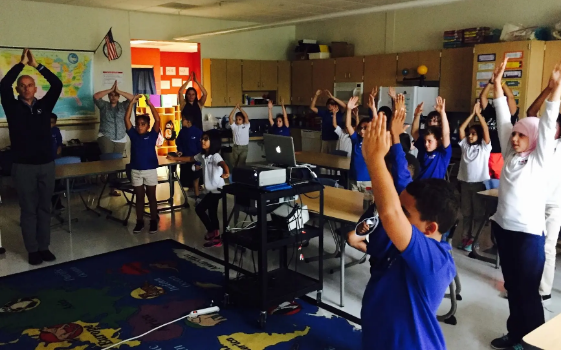
。。。布莱恩吉泽
我们每天发表一篇文章来表彰第五届年度学生社论大赛的前 10 名获奖者。
下面是汉娜·阿梅尔(Hannah Amell)的文章,15岁。
Some tap pencils relentlessly against desks. Some remain completely unaware of their rapidly bouncing knees or shaking feet. Some stare into space, lost in whatever daydream that is playing out on the board in front of them, unable to see the math problems on it. Some turn to their phones for a source of interaction — a teacher’s worst nightmare.
Students are restless. And what do schools require them to do? Sit.
The recent implementation of block scheduling in about 30 percent of American high schools is intended to allow students more time to process information and be productive in class. However, productivity is difficult to measure when, throughout 90 minutes of sitting still, students become restless and disengage, hindering their opportunities to learn and wasting their teachers’ time. There could be a simple solution to this problem with multiple benefits: increased movement in the classroom.
Exercise enhances concentration, especially when repeated throughout the day. For many students, walking from one class to another is the only opportunity to move during the school day, and with a block schedule that varies from day to day, physical education class is not the answer.
A high school teacher found after following students for two days that sitting all day left her feeling lethargic and “desperate to move or stretch.” She also experienced difficulty paying attention due to prolonged inactivity, claiming she struggled to keep her “mind and body from slipping into oblivion after so many hours of sitting passively.” Similar results were found by the Institute of Medicine; children who are regularly active “show greater attention, have faster cognitive processing speed and perform better on standardized academic tests than children who are less active.”
The detriments of sitting for long hours of time extend beyond concentration problems; a lack of frequent activity can cause lifelong issues. A study by Stanford University found that long periods of inactivity, specifically sitting, can contribute toward the development of type-2 diabetes, heart disease and obesity.
School requires students to sit for nearly seven hours every day. This disturbs students’ education and puts their health at risk. Simply incorporating movement into classroom activities, stretching during class and offering alternatives to sitting still will improve students’ grades and health.
School’s purpose is to educate students, but the current structure of our schools is an obstacle to students’ education. When will school be designed for the students?
Works Cited
Cruz, Donna De La. “Why Kids Shouldn’t Sit Still in Class.” The New York Times, 21 March 2017.
James, Julia. “High School Students Sit for Too Long, New Health Research Suggests.” Peninsula Press, 10 April 2011.
Strauss, Valerie. “Teacher Spends Two Days as a Student and Is Shocked at What She Learns.” The Washington Post, 24 Oct. 2014.